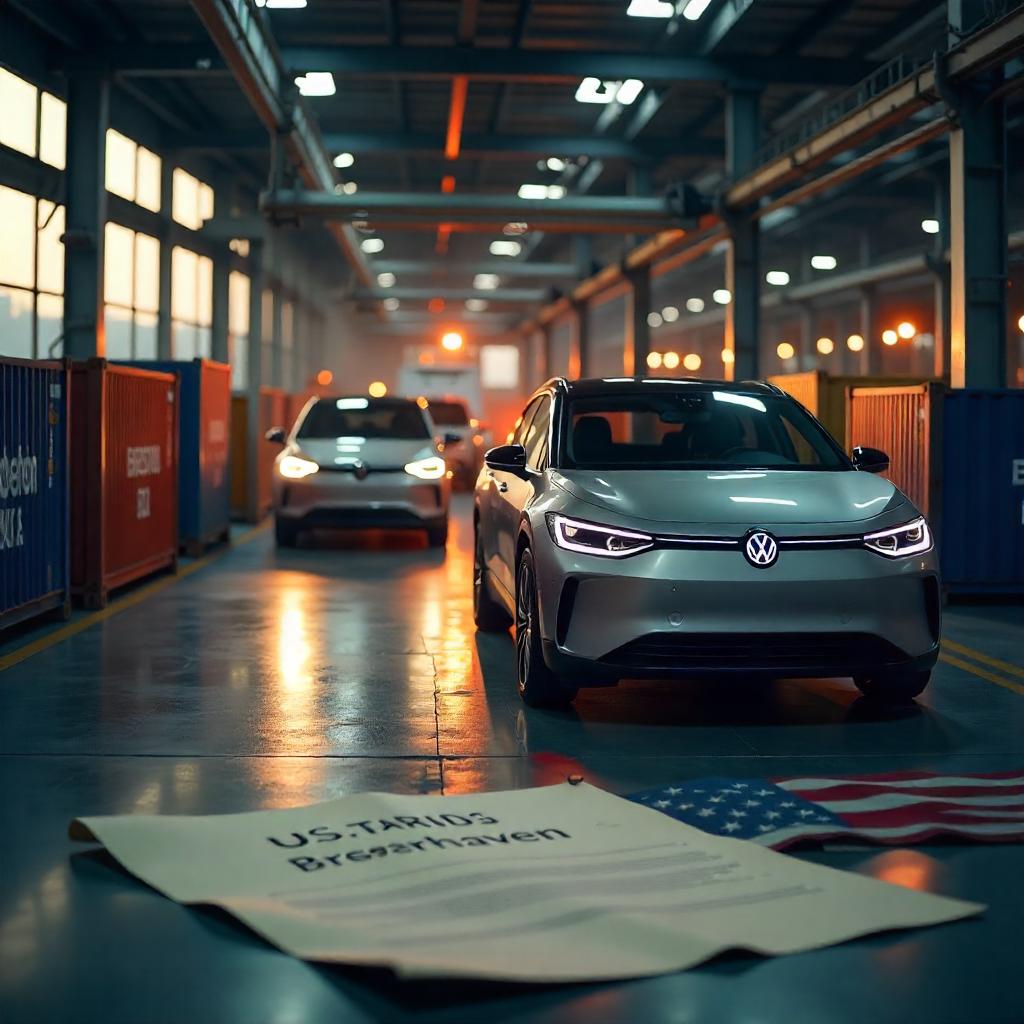The High-Stakes Tariff Standoff
The transatlantic auto trade faces its most critical moment in decades. EU automakers confront devastating 25% U.S. tariffs on vehicle imports—a seismic policy shift imposed by the Trump administration in April 2025 atop existing 2.5% duties. With barely three weeks until the August 1 deadline for broader 10% baseline tariffs, this isn’t just a trade dispute—it’s an existential threat to Europe’s $38.9 billion annual U.S. auto export market.
European manufacturers aren’t waiting passively. They’re executing a high-stakes counterstrategy: offering major U.S. production investments as bargaining chips to secure urgent tariff relief. Volkswagen, BMW, and Mercedes-Benz lead this push, negotiating directly with U.S. officials for exemptions tied to factory expansions and job creation. Their survival hinges on neutralizing these tariffs before the August cliff edge.
For policy analysts, this conflict exposes deeper fractures. The U.S. demands manufacturing reshoring, while the EU fights to protect industrial stability. Brussels has drawn a “red line” on auto tariffs, insisting any deal must include immediate concessions—not phased compromises. With 20% of European auto production destined for U.S. buyers and up to 50,000 EU jobs at immediate risk, the economic calculus is brutal.
The clock ticks louder daily. Failure means $8,000 price spikes on popular EU models and potential supply chain disintegration. Success demands unprecedented concessions—from export credit systems to ironclad “stand-still” clauses barring future U.S. tariff hikes. One misstep could fragment global auto trade for a generation.
Historical Context: From Trade Wars to Negotiation Tables
The current standoff didn’t emerge overnight. It’s the culmination of escalating transatlantic tensions with deep roots in U.S. trade policy shifts.
The Escalation Timeline
April 2025 witnessed the Trump administration imposing 25% tariffs on imported automobiles (adding to the existing 2.5% duty) and 50% tariffs on steel, citing “persistent trade imbalances” and national security concerns. By May-June 2025, the EU retaliated with a formal WTO challenge while preparing targeted tariffs on U.S. agricultural exports. July 2025 saw Brussels pivot to negotiations, proposing a universal 10% baseline tariff and sector-specific exemptions.
Precedent as Blueprint
U.S. deals with other allies set critical templates for EU automakers. The Vietnam Agreement reduced auto tariffs to 20% in exchange for Vietnamese investment in U.S. semiconductor plants. The U.K. Deal granted a 100,000-vehicle annual import quota with 10% tariffs for manufacturers meeting U.S. production thresholds.
The EU’s Fragile Position
European automakers face asymmetric vulnerability with 20% of EU auto production (1.5 million vehicles annually) targeting U.S. consumers. Supply chain exposure compounds this risk, as 50% steel tariffs directly raise production costs for EU factories within Europe, where many rely on U.S.-sourced specialty metals.
This history reveals a pattern: The U.S. leverages tariffs to force localization, while the EU’s delayed counterstrategy heightens its disadvantage. Without a deal by August 1, the 10% baseline expansion could cripple non-automotive sectors like pharmaceuticals and machinery.
Strategic Investment Approaches by EU Automakers
European automakers aren’t begging for mercy. They’re deploying calculated U.S. investments as strategic leverage to dismantle tariff barriers. Each move targets specific vulnerabilities in U.S. policy.
Volkswagen’s “Localize or Lose” Gambit
VW leads the offensive with high-stakes bets. Its Rivian EV Joint Venture accelerates production of electric vans in Illinois, directly tying expansion to tariff exemptions. The company issued an Audi Plant Ultimatum, threatening to cancel a $2.1 billion South Carolina EV factory unless granted 25% tariff relief. CEO Oliver Blume personally negotiates with Commerce Secretary Lutnick, linking 100,000 indirect U.S. jobs to concessions.
BMW & Mercedes: The Export Credit Playbook
BMW leverages its Spartanburg (SC) Hub, producing 60% of its X-series SUVs for global export. It demands “duty credits” against imports based on export value. Mercedes invests $1.4B in Alabama EV battery plants, arguing new tariffs penalize existing USMCA-compliant operations.
Industry-Wide Supply Chain Offensive
Beyond assembly plants, EU automakers attack tariff pain points through steel sourcing shifts—replacing European suppliers with U.S. partners despite 50% cost premiums. Battery localization co-investments with U.S. firms like QuantumScape aim to meet IRA “Made in America” thresholds.
| Company | Key Investment | Tariff Target | U.S. Jobs Created |
|---|---|---|---|
| Volkswagen | Audi SC plant + Rivian JV | 25% auto import duty | 4,200 (direct) |
| BMW | Spartanburg EV expansion | Export credit system | 1,800 |
| Mercedes | Alabama battery facility | 50% steel tariffs | 1,200 |
| Industry | U.S. steel sourcing deals | Input cost reduction | N/A (supply chain) |
This isn’t charity. Every dollar invested aims to make EU automakers’ U.S. tariffs exposure mathematically unsustainable for Washington. As one BMW executive noted: “We’re giving them jobs. They’d lose more by enforcing these tariffs than waiving them.”
Negotiation Dynamics: Quotas, Credits, and Red Lines
Negotiations have hardened into a battle of irreconcilable frameworks. EU automakers’ U.S. tariffs survival hinges on dismantling the 25% wall—but the U.S. insists concessions must be “earned” through investment compliance.
EU Non-Negotiables: Speed and Certainty
Brussels demands immediate auto import duty reductions from 25% to 10% by August 1—no phased implementation. It insists on a legally binding “stand-still clause” prohibiting future U.S. auto or steel tariff hikes. The EU rejects U.K.-style import ceilings as “managed decline.”
U.S. Counterplays: Carrots with Strings
Washington’s offers remain conditional. Its export credit system proposes duty-free import allowances matching dollar value of an automaker’s U.S.-built exports. Investment waivers would exempt companies expanding U.S. production capacity by >15% before 2026. Steel tariff exclusions require manufacturers to use >55% U.S.-sourced steel by 2027.
The Unbridgeable Gaps
| Issue | EU Position | U.S. Position | Status (July 2025) |
|---|---|---|---|
| Tariff Baseline | 10% max for all sectors | 10% minimum for autos | Deadlocked |
| Tariff-Rate Quotas | “Unacceptable” | Model for all allies | EU rejected draft text |
| Retroactive Relief | Waivers backdated to April 2025 | “No reimbursement” | U.S. refused |
| Non-Auto Sectors | Pharmaceuticals included | “Automotive focus only” | Talks suspended |
Brussels insists any deal must cover all EU sectors. Washington calls this “extortion,” noting semiconductor and pharmaceutical tariffs fund the CHIPS Act. EU Trade Commissioner Valdis Dombrovskis fired back: “We won’t sacrifice hospitals to save car factories.”
The collateral damage has begun. BMW halted shipments of EU-built 5 Series models. VW diverted a cargo ship to Mexico. With 10 days until the August 1 deadline, EU automakers face U.S. tariffs with no safety net.
Policy Implications: Winners, Losers, and Systemic Risks
The standoff creates cascading consequences beyond trade statistics. Policy failures now manifest in plant closures, inflation spikes, and global supply chain fractures.
The EU’s Lose-Lose Calculus
Agreeing to U.S. terms accelerates production flight—BMW’s Munich plant could lose 40% of U.S.-bound X5 orders to Spartanburg by 2026. No deal means 25% tariffs adding $4,700-$8,300 per vehicle, triggering a projected 1.5 million annual unit sales collapse in the U.S. market. German unions warn 50,000 EU jobs depend on U.S. exports—but reshoring sacrifices 22,000 European roles.
U.S. Self-Sabotage
Washington’s rigid stance backfires spectacularly. Stellantis closed its Illinois plant (3,200 jobs) after Mexico’s retaliatory steel tariffs made parts unaffordable. Hyundai paused its $5.1B Georgia EV factory, citing “regulatory uncertainty.” Tariffs penalize automakers like Mercedes that already meet 75% USMCA regional content rules.
Global Supply Chain Fragmentation
| Systemic Risk | Evidence (July 2025) | Impact Timeline |
|---|---|---|
| Critical Parts Shortages | Bosch halts U.S. sensor shipments over 50% steel tariffs | Q4 2025 |
| Forced Nearshoring | 30,000+ vehicle components lack U.S. suppliers | 2026-2028 |
| China’s Counterstrike | 125% tariffs on U.S. luxury EVs; rare earth export controls | Immediate |
Beijing’s Ministry of Commerce explicitly linked its rare earth restrictions to “U.S. economic coercion,” weaponizing materials vital for EV motors and batteries. Volkswagen rerouted $1.2B in battery investments from Germany to Tennessee. BMW slashed R&D spending by 9% to fund Spartanburg upgrades.
Broader Economic Consequences
The tariff conflict’s shockwaves now threaten macroeconomic stability across continents. Policy analysts must confront three irreversible consequences.
Inflation on Autopilot
U.S. consumers bear the heaviest burden. 25% tariffs would add $5,600–$8,300 to popular EU models like the BMW X5 and VW ID.4. Domestic ripple effects emerged as Ford raised F-150 prices by 6% citing “elevated steel costs” despite 90% U.S. content. Mercedes EQE lease costs jumped 22% in Q2 2025, slowing the U.S. electric transition.
Labor Market Distortions
| Paradox | Data | Consequence |
|---|---|---|
| U.S. Worker Shortages | 8M job openings vs. 6.8M unemployed | Can’t staff reshored factories |
| European Layoffs | 50,000 auto jobs at risk | Skills base erosion |
| Wage Inflation | Alabama auto wages up 14% YoY | Raises production costs 5–7% |
Investment Paralysis
Hyundai’s $21B Georgia EV hub construction halted over “unpredictable duty exposure.” VW’s Tennessee battery expansion faces delays, with potential relocation to Mexico if tariffs stand. Rivian canceled a $1.8B German plant, blaming “trade fragmentation.”
Global Systemic Threats
China’s 95% control of magnet materials forced BMW to stockpile motors, adding $200/vehicle costs. The euro dropped 9% against USD since April, worsening EU inflation. Forcing suppliers like Continental to duplicate factories raises global auto part costs 12–18%.
JPMorgan warns U.S. auto inflation could add 0.6% to CPI while slashing sector GDP by 1.2%—a policy contradiction Washington ignores. As Bosch’s CEO noted: “We’ll pay $8,000 more for a car to ‘save’ $3,000 in trade deficits. Only politicians win.”
Navigating a Fragmented Future
A limited deal now appears inevitable—but with painful compromises. Expect auto tariff exemptions only for EU automakers announcing U.S. investments before the deadline. Pharmaceuticals and semiconductors won’t be included. The 50% steel tariffs will likely remain, raising production costs permanently.
Long-Term Industrial Reshaping
BMW forecasts 4-6% margin cuts through 2028 as $12B in forced U.S. investments divert R&D funds from EV innovation. 22,000 EU auto jobs face elimination by 2026 despite new U.S. factory roles—skills mismatches prevent direct transfers. Beijing’s rare earth controls ensure even U.S.-built EVs depend on Chinese materials, creating new vulnerabilities.
Policy Imperatives
| Stakeholder | Critical Action | Rationale |
|---|---|---|
| EU | Fast-track critical minerals alliances with Canada/Australia | Reduce rare earth dependence on China |
| U.S. | Replace tariffs with IRA-style production tax credits | Maintain jobs without supply chain taxes |
| Automakers | Build redundant “region-locked” supply chains | Absorb future trade shocks |
The New Normal
Global auto trade won’t recover. Regional silos are forming: U.S.-built for Americas, EU production for EMEA, and Asia-Pacific self-blocs. This fragmentation brings stability but at staggering cost. Redundant supply chains will raise vehicle prices 15-18% globally by 2030. As Volkswagen’s negotiator starkly concluded: “We’re not avoiding EU automakers U.S. tariffs pain anymore. We’re choosing which limb to amputate.”
The August 1 deal won’t end the conflict. It merely defines the battlefield. For policy analysts, the urgent question shifts from “How do we stop this?” to “How do we manage the new auto trade cold war?” The answers will shape industrial strategy for decades.





